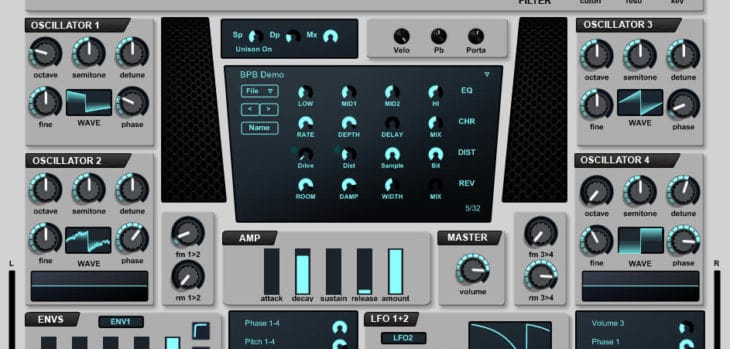Noizefield has put out a good number of impressive freebies in recent history, and their newest software synthesizer is certainly no exception. Once again, partnered with Swedish developers Johan and Carl from Infected Sounds, Splash is a capable instrument perfect for dialing in punchy, aggressive EDM/House style sounds on the fly.
As is the case with most freebies, Splash is a 32-bit VST plugin for PC/Windows only. However, many host applications now have integrated bridging; I was able to bridge Splash in the latest version of FL Studio without too much problem, aside from the GUI bugging out just a bit.
Splash has four oscillators and a noise generator, each with a dedicated amplitude knob within the global Controls section with a small panel wherein you can choose between two different types of noise (white/pink) as well as pitch-bend range, velocity on/off, up to eight voices of polyphony, legato and portamento modes and tuning plus or minus five octaves.
See also: Free 4 Tune Virtual Synthesizer By Noizefield!Each oscillator has four pitch controls (octave/semitone/detune/fine) plus a phase control, which is crucial because all four oscillators are hard-synced at 50% phase, so you might want to grab an oscilloscope and shift the phase if you want to create more organic sounds.
Each oscillator has sixty built-in waveforms from classic sine, saw, pulse and triangle waveforms to pulse waves of varying widths, saw/pulse combinations and wildly experimental waveforms that defy classification, very often sounding harshly resonant, which makes them perfect for extreme filter modulations… which I’ll get to later.
Also, there are two FM modes and two RM modes: FM1>2 & FM3>4, and RM1>2 & RM3>4. I’m not too crazy about the way that envelopes and LFOs scale the depth of frequency modulation. I would prefer to scale the amplitude of the modulator signal completely, but it appears that only a small percentage of the modulator signal output is scaled by the modulation source.
There are two modulation envelopes and two LFOs, each with identical modulation matrixes with four slots and nineteen targets. The modulation envelopes have three adjustable curves for attack, decay and release stages, and both LFOs have forty-two waveforms, and are by default synced to your host application’s project tempo.
There’s also a global amplitude envelope, a master volume control, and a global filter with three modes: low-pass, high-pass and band-pass, each with a twelve and twenty-four decibel slope. At the heart of Splash’s interface are level controls for unison, velocity, pitch-bend and portamento. Whatever is going on with the unison (“fatner”) engine, the result is less than flattering, but with the “Fatner Mix” level at very slight values, you can thicken up a sound in a very satisfying way.
Just below the preset browser, which will load banks of thirty-two presets in .txt format, there are controls for EQ, chorus, drive/distortion/bit-crusher and a noticeably metallic reverb, which isn’t the end of the world; there are plenty of free reverbs cataloged on BPB you can slap in a send bus. I really do like the chorus effect, which reminds me of the wonderful TAL-Chorus-LX.
Splash might have a considerable margin for improvement, but in my personal opinion, the pros outweigh the cons. I quite enjoy the simplicity of this synth. The GUI doesn’t hurt to look at, so it’s a joy to program. Bass sounds are exceptionally punchy. The twenty-four decibel low-pass filter has plenty of attitude. I like it! Seriously, go check it out on the product page linked below.
Splash is available for free download via Noizefield (2.67 MB download size, ZIP archive, 32-bit VSTi plugin format for Windows, made with SynthMaker).



3 Comments
servant
onLooks like Phat Camel
Toaster
onnothing new except the ui (really nice), it sounds exactly like the 4 Tune vsti.. it’s a clone…
Roman
onSimilar, but not quite. Also this one more comfortable and versatile imo.